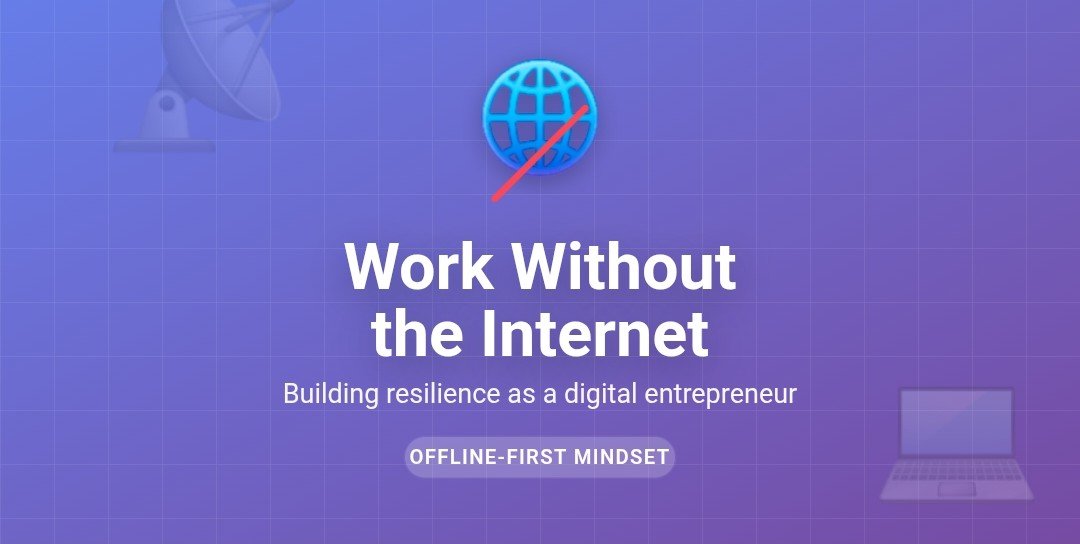There’s a peculiar irony in being a digital entrepreneur: your entire business lives online, yet your productivity shouldn’t depend on it.I learned this the hard way during a cross-country flight when my laptop battery died two hours in. I had five hours of “productive time” ahead of me, but without WiFi and power, I was suddenly useless. That’s when it hit me—I’d built my entire workflow around constant connectivity, and it was a critical weakness.
The Hidden Fragility of Always-On
We’ve normalized being perpetually connected. Cloud-based everything, real-time collaboration tools, streaming music to focus—it all seems efficient until it isn’t. Your internet goes down during a critical project deadline. You’re working from a café when their router crashes. You’re traveling through areas with spotty coverage. Suddenly, hours of potential work evaporate because you never prepared for disconnection.The modern digital entrepreneur faces an uncomfortable truth: the very infrastructure that enables our work also creates a single point of failure. When everything requires an internet connection, you’re not just dependent on technology—you’re dependent on circumstances entirely outside your control.
Building Your Offline Arsenal
Setting yourself up for offline work isn’t about rejecting connectivity. It’s about creating resilience. Start with your tools. Choose software that functions offline first and syncs when connection returns. Your writing app, project management system, design tools—all should have robust offline modes. I switched to applications that store data locally and treat cloud syncing as a convenience, not a requirement.Download reference materials aggressively. That tutorial you might need? Save it. Industry reports? Download them as PDFs. Code libraries and documentation? Keep local copies. This isn’t hoarding—it’s infrastructure. Think of it like keeping a well-stocked toolbox rather than relying on borrowing tools from neighbors who might not be home.
Organize your projects so they’re self-contained. If you’re writing content, have all your research, outlines, and drafts in local folders. If you’re developing software, ensure your development environment runs entirely on your machine. If you’re designing, keep asset libraries stored locally. The pattern is clear: pull everything you might need into your immediate digital space.## The Productivity ParadoxHere’s what surprised me most: working offline made me more productive, not less. Without the constant pull of notifications, email, and “quick” browser searches that spiral into hour-long rabbit holes, I entered a state of deep focus that’s increasingly rare. Offline work forces intentionality. You can’t just jump between tasks on a whim. You have to commit.This constraint breeds creativity. When you can’t immediately Google every question or outsource every problem to an online tool, you think harder. You solve problems with the resources at hand. You discover capabilities in software you already own instead of always searching for the next app.
Practical Implementation
Start small. Identify your most important work—the tasks that actually move your business forward. For most digital entrepreneurs, it’s creating content, developing products, or strategic planning. Make sure you can do these things without internet access.
Set up a monthly routine where you audit your offline capabilities. Test your setup by working in airplane mode for half a day. You’ll quickly discover gaps: that crucial spreadsheet stuck in Google Sheets, that design asset only available via cloud storage, that note buried in an online-only tool.
Create an offline workflow document. List every tool you use, note which work offline, and identify alternatives for those that don’t. Keep this updated as your business evolves. When you discover a new dependency, immediately ask yourself: what’s my offline backup plan?
The Broader Benefits
Beyond productivity, offline capability gives you freedom. You can work from anywhere—actually anywhere, not just anywhere with good WiFi. Mountain cabins, international flights, remote locations, or just your backyard when you want to disconnect. Your work location becomes truly flexible.It also builds sustainability. Constant connectivity is exhausting. The ability to work offline gives you permission to truly disconnect during off-hours. When your work requires internet, there’s always a rationalization for “just checking one thing.” Offline work has clean boundaries.
The Digital Minimalism Angle
Setting up for offline work naturally pushes you toward digital minimalism. You can’t maintain fifty cloud subscriptions and browser extensions when working offline. You’re forced to identify what’s truly essential. This clarity extends beyond just offline scenarios—it streamlines your entire workflow.You stop being a collector of productivity apps and start being a practitioner of actual productivity. The question shifts from “what’s the best tool for this?” to “can I do this with what I already have?” Usually, the answer is yes.## Moving ForwardThe goal isn’t to work offline all the time. It’s to be capable of it. When you build this capability, you gain resilience, focus, and freedom. You’re no longer held hostage by connectivity. Your productivity becomes internally controlled rather than externally dependent.
Start today. Pick one project and set it up to be completely self-sufficient. Experience what it’s like to work without that invisible tether. You might find, as I did, that the constraint of offline work isn’t a limitation—it’s a superpower.
The internet is a powerful tool for digital entrepreneurs, but it should be just that: a tool you use, not a dependency that uses you. Build your business to thrive online, but build your workflow to survive—and excel—offline.

